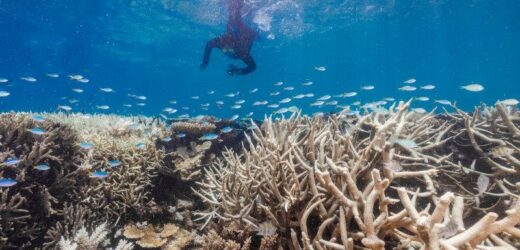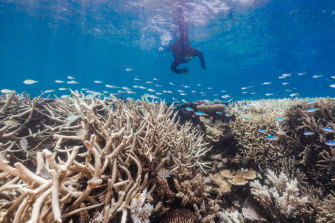Poll after poll shows more Australians than ever are concerned about climate change and want greater action to reduce greenhouse gas emissions and global heating. And they have good reason to be. This summer, even in a cooler La Nina year, temperature records were broken and residents of northern NSW became climate refugees as they fled their inundated homes during record-breaking floods.
From the fierce black summer bushfires two years ago to the recent bleaching – again – of the world heritage-listed Great Barrier Reef, it’s clear that catastrophic climate change is underway and harming Australians here and now. It’s happening from the Pilbara town of Onslow, where super heating in January equalled Australia’s hottest ever temperature of 50.7 degrees celsius, to Doon Doon in NSW, which broke records with more than a metre of rain in two days.
The bleached Stanley Reef in the Great Barrier Reef. Climate change threatens coral reefs with extinction if temperature rises exceed 2 degrees.Credit:Australian Marine Conservation Society, Harriet Spark
Yet many Australian voters feel cognitive dissonance when they contrast the climate election promises of the two major parties with the urgent calls from scientists for quick, deep emissions cuts by 2030. Nowhere has the divergence between scientific evidence and political ideology been more painfully clear than in Australia’s decade-plus climate war.
The Intergovernmental Panel of Climate Change says global emissions must be halved by 2030 to have any hope of limiting global warming to, or close to, 1.5 degrees. It’s stark and simple. What is the “fair share” of this emissions budget for Australia? Replicating the same methodology that the federal government’s Climate Change Authority used in its advice ahead of the Paris conference, two recent University of Melbourne reports determined that if Australia is to stay within its 1.5 degree budget it would require a 75 per cent emissions reduction on 2005 levels by 2030, with net zero by 2035.
Before the COP26 climate conference in Glasgow, the Morrison government opted not to update its emissions target of a 26 per cent by 2030, saying it would be “on track” to reach zero emissions by 2050, though this is not legislated. Under its mantra of “technology not taxes”, the coalition’s net zero plan leans heavily on unspecified “technology breakthroughs”. Investment in clean hydrogen, energy storage, low emissions steel and aluminium and carbon capture and storage (CCS) are prioritised. However, CCS is yet to work anywhere in the world at scale, despite a good deal of investment.
There’s also considerable political support from the government for emissions intensive fossil fuel industries. Prime Minister Scott Morrison has promised $250 million subsidies to Australia’s two oil refineries and $660 million to accelerate fracking in the Northern Territory’s Beetaloo Basin. This vast spend dwarfs the coalition’s commitments for clean energy projects. It also stands in contrast to what the International Energy Agency (IEA) says is needed: no new oil and gas fields or coal-fired power stations can be created if the world is to stay within less dangerous global heating limits. Already, that hope is fading.
As for Labor, it promises to set an emissions reduction target of 43 per cent by 2030 and increase the share of renewables in the national electricity market to 82 per cent. This is less than the 45 per cent cut Labor promised under Bill Shorten ahead of the 2019 election and shows the chilling effect that electoral loss had on the party’s climate ambition. The 43 per cent figure has been forged through the process of political expediency, but will not reduce emissions quickly enough, according to the scientific evidence.
Labor’s Rewiring the Nation policy would also upgrade electricity transmission lines to harness booming solar and wind farms – a shift led by the states – and provide $20 billion in cheaper government-funded loans to transmission companies. It is banking on a massive rollout of renewable energy to drive down emissions from the energy sector, and will impose emissions limits on the 215 largest polluting facilities.
Despite the IEA’s “no new coal power” plea, Opposition Leader Anthony Albanese has committed a Labor government to support new coal mines, matching the pro-mining stance of the Coalition in a push for blue-collar votes. However, for the first time this week Albanese ditched his previous caution over climate policy, declaring renewables were replacing fossil fuel power “in spite of the government, not because of the government”.
The Greens policy is to reduce emissions by 75 per cent by 2030 and net zero by 2035, including subsidies to wean the country off gas. The so-called “teal independents”, have various proposals that lie somewhere between Labor’s and the Greens.
Since the last election, climate change has accelerated and the economy, industry and public attitudes have shifted. In 2019, the Business Council of Australia in 2019 described Labor’s 45 per cent emission reduction pledge as “economy wrecking”. Now it supports an even-greater 50 per cent emissions reduction by 2030 to avoid a “costly and damaging” game of climate catch-up. The uptake of renewables in Australia has soared – thanks largely to state government policies – and global forums like COP26 in Glasgow have increased the pressure on climate laggards to act.
Neither of the major parties have the emissions reduction policies the scientists say we need, but Labor would be less of a climate wrecker than the Coalition. The Coalition and Labor may struggle to form government on their own, meaning the Greens or independents could hold the balance of power after this election. Climate action would then become a bargaining chip.
Gay Alcorn sends an exclusive newsletter to subscribers each week. Sign up to receive her Note from the Editor.
Most Viewed in National
From our partners
Source: Read Full Article



